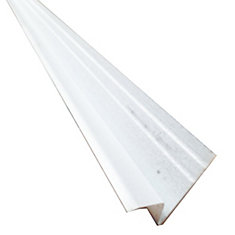
Breaking News
Main Menu
How To Install Duraflash Vinyl Deck Flashing Installation
вторник 23 октября admin 14
The correct flashing with the proper profile is seen overlaying the inferior deck flashing that was installed by a nonprofessional. PHOTO CREDIT: Tim Carter DEAR TIM: I need to install a deck ledger board against a house with wood lap siding. Soon I'll be doing the same on a brick home.
AsktheBuilder.com: Installing a deck flashing properly is critical to keep water from getting behind the ledger board. The deck flashing needs to overlap the deck ledger board much like shingles overlap. Follow these tips when installing flashing on your deck.
What's the proper way to install flashing so I don't get any leaks where the ledger board connects to the house? My online research indicates this could be a serious problem.
Something tells me that it's very important to get this right. Tony P., Waltham, MA DEAR TONY: Your research is spot on. Leaks at or around deck ledger boards are a serious issue. A couple of years ago, a new home was being constructed next door to me. I was stunned when I saw the builder nail a deck ledger board directly to the side of the house. Not only was no flashing installed, the builder nailed, instead of through bolting, the board directly to the oriented strand board sheathing with no water membrane behind it.
It's a shame that many young carpenters, builders and homeowners don't connect the dots about how the exterior finishing material on a home - be it wood, brick, stone, vinyl, etc. - needs to act just like shingles on a roof. Traditional asphalt shingles keep you dry inside because one shingle overlaps another as they march up the roof. A deck ledger board needs to do the same thing.
It needs to be just one more component in a waterproof assembly on the side of a home. The trouble is, it takes some skill to make this happen. In the case of your wood siding, it's not too tough.

What's more, there are new flexible membrane flashings that may make the job easier for you. I'm a little concerned about these new materials. I'm a fan of metal because I know it will work and is much tougher than the membranes. Some of the membranes are sensitive to ultraviolet light, and may break down if they are exposed to sunlight. Be sure you read the product label about exposure to direct sunlight.
Stop and think about how wood lap siding works to keep your walls dry. Each piece above the one below overlaps so that water can't get behind each piece of siding. You need to use flashings to provide this same overlapping effect where the deck ledger board connects to the house. Once you've cut away the siding at the deck ledger location, you install a metal or membrane flashing that overlaps the siding below the ledger board.
The previous works on Hamzah’s teachings and ideas have not been so comprehensive but covered the small portions of his poetic verses.478-489). The field is the Malay Islamic philosophical mysticism as found and based on the prose and poetic works of Hamzah Fansuri. The mysticism of hamzah fansuri pdf. Free Download e-Books Chlamydia Test CT chlorine Cl cholesterol CH. Free Pdf Download, the, mysticism, of, hamzah. The mysticism of hamzah fansuri Download the mysticism of hamzah fansuri or read online here in PDF or EPUB. Please click button to get the mysticism of hamzah fansuri book now. All books are in clear copy here, and all files are secure so don't worry about it. Sumbangan hamzah fansuri.
This needs to overlap the siding at least as much as the wood siding did before you cut it away. What's more, the metal flashing needs to be bent so the bottom 3/8 inch of the flashing is bent at a 30-degree angle so it doesn't touch the siding. This little kick out allows water flowing over the flashing to turn to droplets that fall to the ground.
If you don't do this and the bottom of the flashing is in direct contact with the siding, capillary attraction can pull the water up so it leaks behind the siding. This first piece of flashing needs to extend up at least 2 inches behind the deck ledger board. You then attach the ledger board to the wall using approved through bolts, not lag bolts. Drill the holes through the ledger board the exact same diameter as the shank of the bolt so it's a tight fit. Use a heavy rubber flat washer that will get sandwiched between the ledger board and the metal washer that's under the head of the bolt.